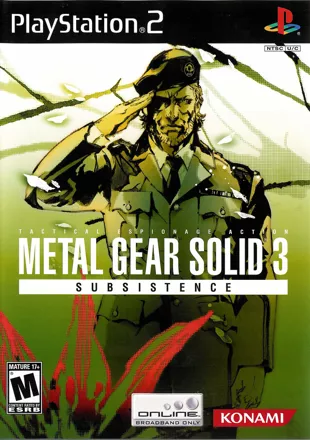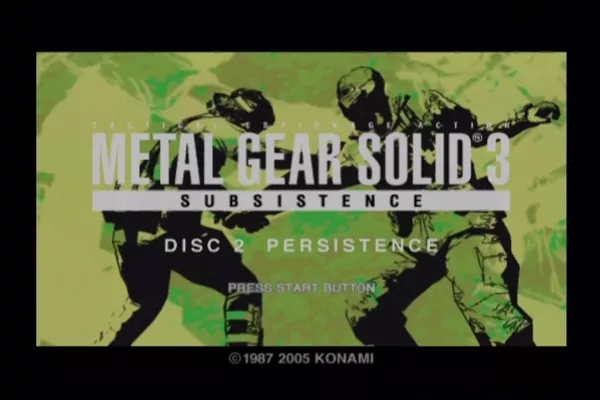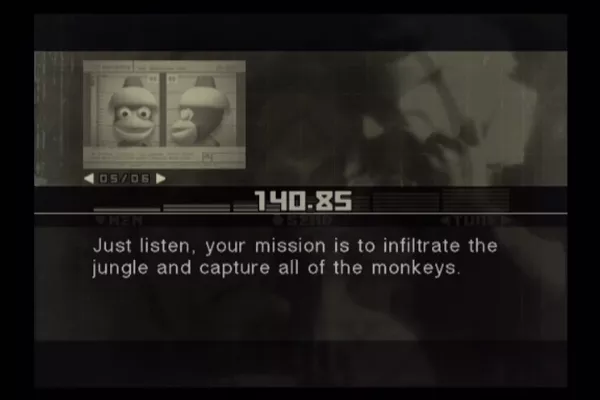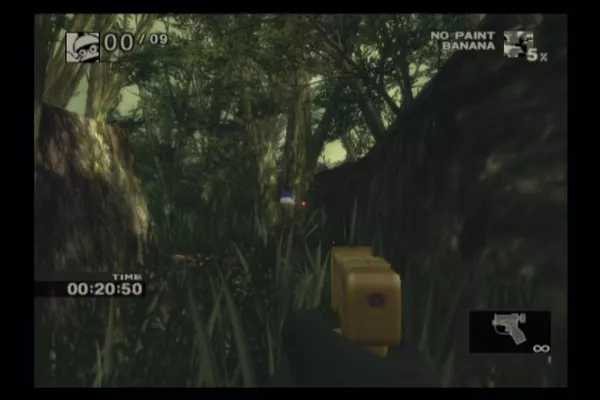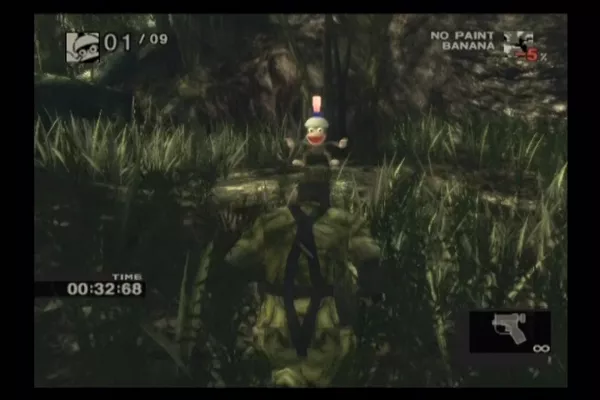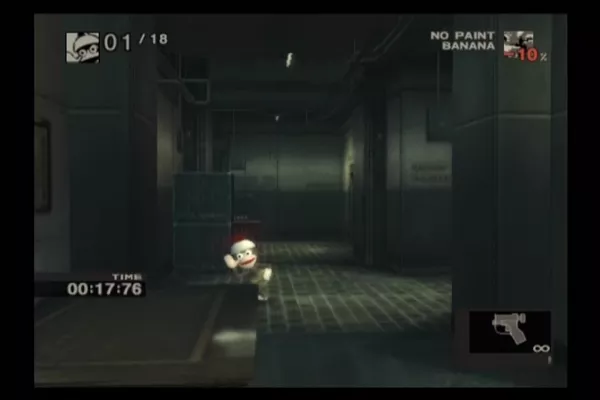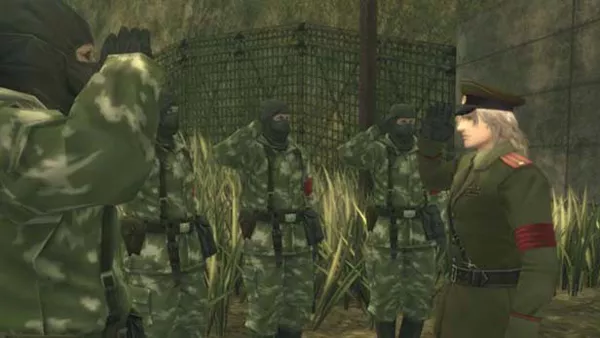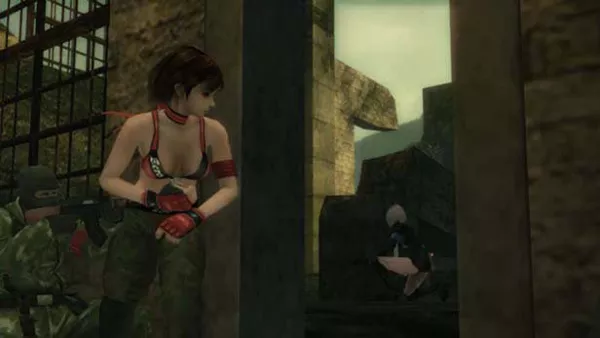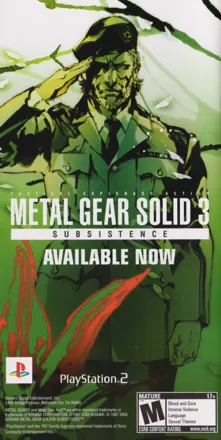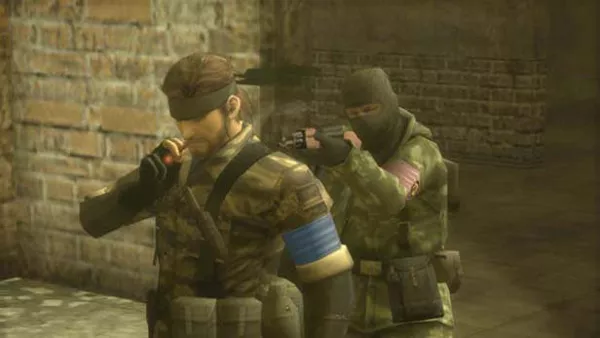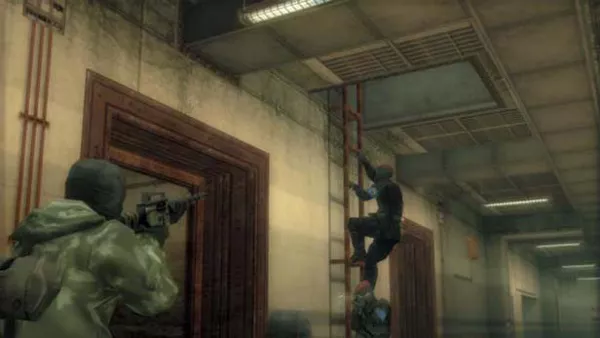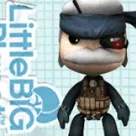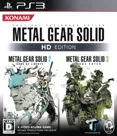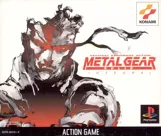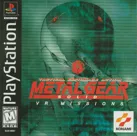Metal Gear Solid 3: Subsistence
Description official description
Metal Gear Solid 3: Subsistence is an enhanced version of Metal Gear Solid 3: Snake Eater.
Included with the release is the entire game of MGS3: Snake Eater with a number of additions. The European Extreme has been added as an available difficulty level, being the hardest difficulty level in the entire series. New face paints and more camera angles have been added to the mix, as well as a myriad of other features including a Duel Mode, allowing players to face off against their favorite bosses anytime they want. Back by popular demand, Snake vs. Monkey has also returned with more maps than before!
Besides this, included on the bonus disk is a new online mode. This new mode allows players to play MGS3 online with other players around the world. Sony's servers allow the player to keep track of stats and friends. Players can play with others around the world in different match types such as Capture missions and Sneaking missions. To wrap up the original trilogy, Subsistence comes with the original version of the MSX games Metal Gear and Metal Gear 2: Solid Snake. Never before released in America, the inclusion of these two games wraps up the entire series of games in the original trilogy of the origins of Solid and Naked Snake.
Groups +
Screenshots
Promos
Credits (PlayStation 2 version)
92 People · View all
| Ocelot | |
| Raikov/Raiden | |
| Sokolov | |
| The Boss/Rosemary | |
| Soldiers | |
| Reiko Hinomoto/Rowdy Reike |
|
| Artists | |
| Lead Artist | |
| Artists | |
| Lead Artist | |
| Animator | |
| [ full credits ] | |
Reviews
Critics
Average score: 92% (based on 69 ratings)
| Critic [ Expand All ] | Platform | Score |
|---|---|---|
| Game Chronicles | PlayStation 2 | 100% |
| GameSpy | PlayStation 2 | 100% |
| GamePro (US) | PlayStation 2 | 100% |
| Nuts | PlayStation 2 | 100% |
| Game Vortex | PlayStation 2 | 100% |
| Deeko | PlayStation 2 | 100% |
| EmpireOnline.com | PlayStation 2 | 100% |
| Game Over Online (USA) | PlayStation 2 | 100% |
| Thunderbolt Games | PlayStation 2 | 100% |
| TotalPlayStation | PlayStation 2 | 100% |
| GameZone | PlayStation 2 | 100% |
| GamerDad | PlayStation 2 | 100% |
| 1UP (USA) | PlayStation 2 | 100% |
| AceGamez | PlayStation 2 | 100% |
| GamesRadar | PlayStation 2 | 100% |
| Game industry News (GiN) | PlayStation 2 | 100% |
| Game Shark | PlayStation 2 | 100% |
| Joypad | PlayStation 2 | 100% |
| Digital Fix, The | PlayStation 3 | 100% |
| KRESNIK258GAMING | PS Vita | 100% |
| PSX Extreme | PlayStation 2 | 99% |
| Lawrence | PlayStation 2 | 99% |
| IGN | PlayStation 2 | 98% |
| PGNx Media | PlayStation 2 | 97% |
| Game Freaks 365 | PlayStation 2 | 97% |
| GamingExcellence | PlayStation 2 | 96% |
| Mygamer.com | PlayStation 2 | 96% |
| Play.tm | PlayStation 2 | 96% |
| Worth Playing | PlayStation 2 | 95% |
| Futuregamez.net | PlayStation 2 | 95% |
[ 39 More ]
Players
Average score: 4.1 out of 5 (based on 62 ratings with 4 reviews)
I don't know what I can say that hasn't already been said.
The Good
Metal Gear Solid 3: Snake Eater shows that video games, particularly since the mid-2000s, have a much more consistent track record in terms of delivering worthy sequels to the original work; and Metal Gear Solid 3 is certainly no exception to this trend. It's an alternate history masterpiece that once again tackles the topic of nuclear warfare which is still shockingly relevant for today just as it was in 1964 (the game's period).
You're Snake (or Big Boss) infiltrating the Soviet Union to save a Russian rocket scientists from The Cobra Unit, a rouge-faction of renegade soldiers sworn to fight against the United States at all costs. They're led by Snake's mentor, The Boss, whose betrayal sets in motion the story of The Metal Gear Saga. Fighting in the Soviet Jungle, you must never be seen by the enemy or risk the future of mankind to a nuclear holocaust.
The Bad
Sometimes getting spotted doesn't take too much. It can be easy to avoid detection, but the system's not perfect. It does help the player improvise in a more composed manner.
The Bottom Line
Snake Eater is James Bond mixed with Doctor Strangelove and Captain America, crossed with The Great Escape.
Be the first to rate this review!
Did you find this review helpful?
PlayStation 2 · by John H. (52) · 2019
The Good
One thing that has begun to aggravate me about the Metal Gear series is how reminiscent each game is of the previous one. Both canon and non-canon games have all followed the same structure; infiltrate an enemy base, rescue hostages, defeat members of an elite team, and prevent nuclear war. While I haven’t fully grown weary of sneaking through corridors patrolled by nearsighted guards, I’m certainly ready for a change. Metal Gear Solid 3: Snake Eater represents the greatest shift the series has seen, moving all the action outdoors and into the jungle and re-focusing on new and exciting mechanics. Yet despite this, what Snake Eater proves most is that the more things change, the more they stay the same.
Snake Eater represents a radical shift in narrative. The story follows the series’ future antagonist, Big Boss, back in the early days when he carried the codename Snake. He’s tasked with the mission of covertly infiltrating an enemy facility, rescuing a civilian scientist, and destroying an enemy super-weapon to prevent nuclear catastrophe. Nope, wait, my mistake. I’m beginning to see a pattern here. Okay, so it’s still the exact same plot as the previous games, only now it’s set in 1964 against the backdrop of the Cold War.
While the story structure remains the same, when it comes to the smaller details, Snake Eater is a completely different beast than the previous games. This time around, the narrative has taken a lot of influence from 1960’s spy fiction right down to a musical interlude in the style of post-Goldfinger James Bond movies. With the change, the story takes a subtly more light-hearted tone, mostly dropping melodramatic elements such as long death monologues and drawn out dialogues about a character’s tortured past. The support characters who you remain in contact with over the codec seem less worried about unloading their emotional baggage on you and more interested in fun banter and in-depth detail about the items you’re carrying. The game hasn’t completely been exorcised of heavy-handed character drama, but the shift in narrative focus has made it less obstructive and slightly more enjoyable.
But it isn’t the story that has been given the biggest shift; the gameplay is almost entirely different than any of the previous titles. Rather than being dropped off at the front door of a compound and left to accomplish his mission, Snake starts off in the middle of a jungle and has to make his way between multiple camps and bases. In a way, it’s a lot like the NES port of the original Metal Gear. While the game’s world is quite linear – more so than even the previous Solid titles – there’s a nice bit of exploration to be had as risk is weighed against reward when searching the undergrowth for new gizmos. Certain areas can be easily traversed, but everywhere holds the possibility of extra gear being tucked away in a corner, should you be willing to risk discovery to get it.
With the shift in terrain come a lot of new elements in the shape of survival mechanics. Rather than simply chowing down on rations to heal, health returns gradually so long as you keep your belly full and your wounds stitched up. New to the game is a stamina bar that dictates not only how well your wounds heal, but also smaller things like how steady your aim is. To keep it topped up, you have to eat food which can be found in storage sheds, on guards, or by hunting animals and snatching certain flora. First-aid must be applied to specific wounds to keep Snake from bleeding out, and while field surgery is pretty simple, the supplies must be obtained from the environment. The survival mechanics really aren’t as deep as they may sound, but they do add a nice bit of character, as superficial as it may be. The field surgery in particular I wish was used more frequently in video games, as it lends a greater feel of interactivity to what is otherwise typically instant.
Finally, there’s the addition of camouflage. Since Snake is no longer wandering the corridors of a grey-blue facility, he can use various camouflage patterns and face paint to try and blend into the environment around him. The soliton radar didn’t exist back in 1964, and the motion detector and sonar you’re provided doesn’t really work the same way. The enemy field of vision is much greater than it was in previous games, and without the soliton radar, you can’t see when you’re entering a guard’s line of sight. To make up for this, a percentage is displayed onscreen to tell you how well you’re blending into your surroundings, and it may be necessary to swap wardrobe to better conceal yourself. With the right outfit, guards may not see you until they actually trip over you.
The Bad
The problem with all of Metal Gear Solid 3’s many new mechanics is that they feel like they belong in a much longer game. Snake Eater was the lengthiest Metal Gear game at the time of its release, but even with it, the opportunity to use some of Snake’s new tricks doesn’t come up often. Survival just isn’t that difficult when there’s so little ground to cover. Certain terrains are only seen once for about two areas each, so many of the animals only exist in small pockets. Food is extremely easy to come by to the point where you might as well not bother hunting since rations, instant ramen, and Calorie Mates can be found in just about any shed and never go rotten. You can get first-aid items from various plants, but these too can be found lying around in large quantities. Larger stretches of wilderness where supplies are less frequent would have been more ideal since at least then you’d be forced to scrounge for everything you can get, rather than always being loaded up with items.
The issue of wasted potential pervades a lot of the game. You practically trip over new gizmos and healing items every few steps, and while this provides a great deal of flexibility in how you approach the game, it lends to a feeling of superfluousness. You have a myriad of options on how you get through the game, but whether you sneak through unnoticed or mow down everyone who gets in your way, it basically all feels the same. The game just isn’t dynamic enough to support all methods of gameplay in a satisfying manner. It has the bizarre trait of being too deep, but not broad enough, and just ends up feeling cluttered.
Despite these minor problems, for most of the game I was practically in love with Snake Eater. Then, during the concluding three or four hours, it falls back into old habits. Boss battles and action setpieces are suddenly sandwiched between tremendously long cutscenes that are absolutely packed with horrendous dialogue and borderline incomprehensible exposition. The final stretch of story that concludes the last boss battle is monstrously long, something like 45 minutes in total, going over who double-crossed who, and how everything was set up from the beginning to play out exactly as it did. It’s bad enough that this gets spewed all over the concluding chapter, but this is the exact same kind of plot twist that has been used in every other Metal Gear Solid game. Not only is the series severely long-winded, it can’t stop repeating itself.
The Bottom Line
While Snake Eater made an attempt at the end to sabotage my enjoyment of the game by dropping a metric tonne of weapons-grade exposition directly on the concluding chapter, I have to remind myself that everything leading up to that was pretty near excellent. The many new survival mechanics that have been layered on top of the series’ standard stealth really makes the experience shine like never before. On top of that, the boss battles are immensely memorable and the 1960’s aesthetic is utilized in many extremely stylish ways. However, it’s become too difficult for me to ignore the tremendous deficiencies in the series’ writing. It’s GOOD enough, but what should have been an outstanding game is dragged down by its inability to fully shed its flabby exposition.
0 of 1 Moby users rated this review helpful.
Did you find this review helpful?
PlayStation 3 · by Adzuken (836) · 2015
Tough and gamey, with a strong aftertaste.
The Good
While MGS2 was a vastly more refined edition of Metal Gear Solid, Snake Eater is more experimental. A prequel, it also serves as the beginning of the storyline for the franchise, chronicling the origin story of Naked Snake, Solid Snake's predecessor as he becomes Big Boss. It also changes around with established series conventions, while making some unique additions of its own in order to better suit its jungle setting.
The biggest change is the lack of the Soliton Radar. No longer can you play by watching a scaled-down version of the map. Now, you must rely on your sense of sight and other tools, such as motion detectors, sonar, and directional microphone, in order to sneak by enemies.
The main feature this time around is the camouflage system. Snake can gather many different disguises, uniforms and face paints that are designed to blend in with the environment. A meter in the top right-hand corner lets you know how visible you are in relation to the current surface Snake is standing on or pressed against - the higher the value, the closer an enemy will need to be in order to detect you when you’re in their field of vision. Moving can lower this value as well. You have to change both uniform and facepaint to make the value as high as it can possibly be for whatever you're standing on. Crouching and crawling can increase the meter dramatically, but at the cost of player speed and mobility. The game also plays with disguises much more than MGS2, with one memorable sequence asking you to knock out a high-raking general so you can infiltrate a hangar being a real standout.
Another major addition is Close Quarters Combat, or CQC as it is often referred to in game. Essentially, what this means is that Snake has a few more options when dealing with enemies using melee. In addition to the traditional melee attacks, Snake can now grab enemies and slam them to the floor, slit their throats, or interrogate them for information such as gameplay tips or radio frequencies. An example of this is that some guards, when interrogated, will give you a codec frequency which you can call during the caution phase to call off the search - though you can only use it once before the frequency is changed again.
In addition, MGS3 has arguably the best story for any Metal Gear Solid game up to this point. The ending in particular is one of the best I’ve ever seen in any video game, wrapping up the plot with a devastating emotional payoff and incredible final twist that honestly made the preceding 25 hours worthwhile despite my reservations.
On top of all of this, survival features have been implemented. Snake will need to kill animals and gather fruits on a regular basis which serve as rations. No longer can you simply eat rations to gain health, instead, eating rations restores Snake’s stamina, while health regenerates slowly over time. Some foods have even stranger effects when eaten, such as restoring your equipped item’s batteries. These natural rations can also rot after a certain amount of real-world time, eating rotten food will cause Snake to get sick and throw up. Eating too little food also causes Snake’s stomach to start growling, which can give away your position to enemies, sometimes at the worst possible moments. In addition, injuries must be treated regularly - leeches have to be burned, antidote must be administered for snake bites (ironic given who you’re playing as), broken bones need to be splinted, and cuts need to be stitched and disinfected.
The Bad
As interesting as these features sound, the one thing that drags them all down is the constant need to head into a different menu screen entirely to adjust them. Practically every minute, you’ll need to change camouflage, and every so often, treat injuries and eat food as well. Even the way items work has been changed. In order to use any of your items, you must first fetch them from your backpack, meaning even more tedious menuwork in order to get what you need out of a tight situation. Items have a certain amount of weight, and carrying a lot of heavy stuff causes Snake’s stamina to drain faster, which forces you to eat more food in order to keep it up. This is supposed to encourage you to only take what you need from the pack at any given time, but all it really does is slow the game down. A couple of boss fights later in the game will have you consistently entering the cure screen so you can remove crossbow bolts and anesthetic needles. The survival elements ultimately don’t complement the game so much as take away from it.
While the narrative is great, it suffers from pacing issues. It doesn’t seem to really go anywhere for much of the game, and only until the back hald do you truly start to get invested. I suppose part of this comes from the fact that there are a lot less mandatory codec calls in this game compared to MGS2, which makes the plot feel like it’s not moving along at times.
I think the thing I miss the most is the whole techno-industrial atmosphere present in the other Metal Gear games. For me, part of the appeal was sneaking through these impersonal, man-made environments. The jungle just isn’t as appealing of a setting for me, despite offering many more opportunities for stealth. Fortunately, the game gets a lot more interesting the further you get into it, as you’ll sneak through both a weapons lab and a large military base called Groznyj Grad that finally brings back that classic MGS feeling. It’s just a shame that you have to trudge through screen after screen of jungles and forests in order to get to the truly good parts.
In addition Snake Eater seems to have performance issues. From my research, the original PS2 version ran at 30 fps, which was down from Sons of Liberty in order to accommodate the increased detail in the naturalistic environments. For the HD release, Bluepoint Games has taken advantage of the next-generation hardware by trying to run MGS3 at 60 fps. I say trying, as despite this, the game still suffers from slowdown, in from what I understand is pretty much the exact same places. When too many particle and explosion effects are on the screen, the game runs like it’s going through mud. You generally don’t see the slowdown so much as feel it. When slowdown occurs, the game ends up looking not exactly choppy, but more like a slow-mo effect that you sometimes see in movies. I have found that switching to the top-down camera view mode helps the framerate somewhat when it gets hairy, but at the cost of visibility. Maybe its my PS3, but the fact that these performance issues are pretty well-documented across all versions of the game suggests that the engine was perhaps pushed a bit too far even in in its original incarnation. Granted, the slowdown really only happens when you get spotted, so if you’re really good at the stealth you aren’t likely to see too much of it outside of the occasional cutscene, but it’s still a pain.
The Bottom Line
My feelings on MGS3 are almost as complicated as the Metal Gear storyline. I started out hating the game at first, with frustrating changes from the other MGS games, and a plot that didn’t exactly grab me from the start. It was only until I got about halfway into the game that I really got invested in what was happening and figured out the flow of the gameplay. That’s not to say that MGS3 is a bad Metal Gear game, or even a bad game at all, as it's actually a very good one. But even with its great story, I have to say that it’s my least favorite installment thus far.
3 of 4 Moby users rated this review helpful.
Did you find this review helpful?
PlayStation 3 · by krisko6 (814) · 2015
Discussion
| Subject | By | Date |
|---|---|---|
| AAAAAAAAAAAARGH @#&$@)#& | Foxhack (32131) | Jun 4, 2008 |
Trivia
Awards
- GameSpy
- 2006 – #8 Console Game of the Year
- 2006 – #4 PS2 Game of the Year
- 2006 – PS2 Action Game of the Year
Analytics
Related Sites +
- JUNKER HQ
This fansite is dedicated to the games produced and/or designed by Hideo Kojima and contains all kinds of trivia, artwork, plot summaries, discussion forums and more. - Metal Gear Solid: The Unofficial Site
A fansite that contains information about the whole Metal Gear franchise, including galleries, interviews, downloadable content and discussion boards.
Identifiers +
Contribute
Are you familiar with this game? Help document and preserve this entry in video game history! If your contribution is approved, you will earn points and be credited as a contributor.
Contributors to this Entry
Game added by Matt Neuteboom.
PlayStation 3, PS Vita added by MAT.
Additional contributors: MAT, Robstein, —-, Patrick Bregger.
Game added March 20, 2006. Last modified September 11, 2024.


